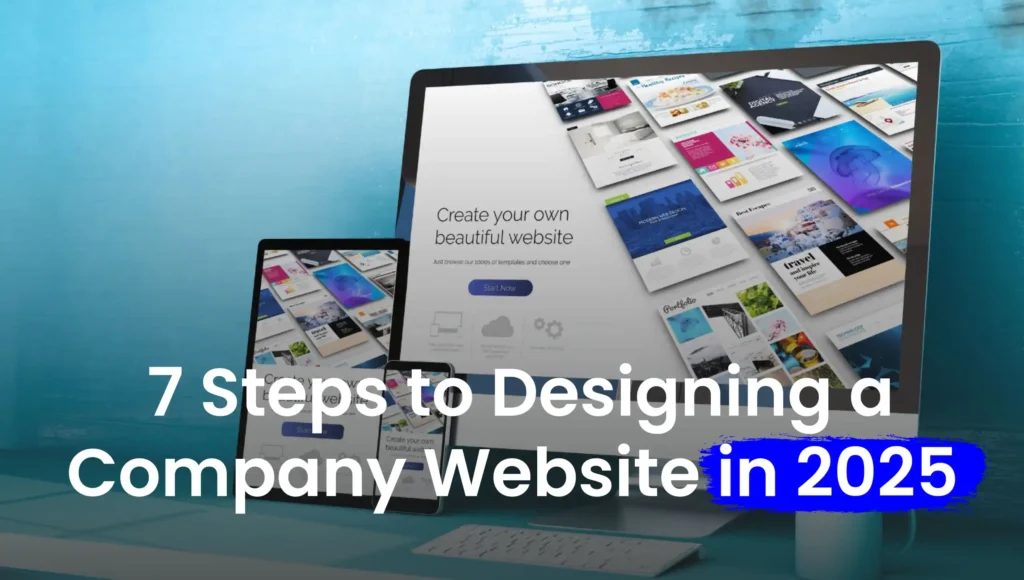With the rise of the digital world, corporate website design has become a key factor of success for any business. Regardless of whether you’re a startup company or a well-established one, a well-designed corporate website is an important part of establishing your brand in the online space. So as the technologies grow and users expectations change, it is important to understand how to design a corporate website in 2025 to keep it unaffected and competitive.
How to design corporate website? Having been in web development for the last 8 years, I have witnessed how a company can either be brought up or pulled down by a website, based on its design and functionality. In this blog, we will take you through the 7 simple steps to design the perfect corporate website in 2025 that will keep your users engaged, apply modern design principles, and also ensure performance optimization.
Learn What a Corporate Website is
What is a corporate website? Before going further in the design process, it is vital to understand what a corporate website is. A corporate website is not just a digital brochure for your business. It is a channel that conveys your brand’s position, beliefs, offerings, and services to your consumers. It is a one-stop destination that provides your visitors with information, sells leads, and even sells, in some cases.
Corporate websites should offer clear messaging, intuitive navigation, and a design that supports your company’s goals and branding. A great corporate website design serves both a company’s professional image and its audience’s needs, be it service offers, product specifications, or support.
What is corporate website? It is a comprehensive digital hub designed to provide information about a company’s products, services, and mission while engaging clients, investors, and stakeholders.
With corporate website design services, businesses can achieve the best corporate website designs that combine functionality, and user-friendliness to enhance credibility and drive growth.
Too many businesses don’t consider the need for lifetime brand consistency online.” For example, I was talking with a client whose website had no branding style, and their services were poorly presented. We redesigned the website for clean and clear design and messaging, and we began to receive more site traffic and client inquiry.
Do Your Research and Articulate Your Objectives
Research and set website goals. Before starting with the actual design, it is important to perform thorough research and set your objective for the website. Understanding your target audience, who your competitors are, and what the main goal of the website is, and all this in the scope of your project.
How to design corporate website? Whatever their goal is, be it informative, product sales, or customer support, having clearly defined goals in the beginning will ensure that your corporate homepage design will serve your business purpose.
During this phase, it’s important to work with both your marketing and business teams to define relevant metrics, such as website traffic and conversion rates, as well as user engagement. A well-designed website is in tune with these KPIs and serves as the means to achieve your corporate goals.
If you are trying to generate more leads, for instance, then you should be embedding call-to-action buttons in a prominent manner, and your contact forms must be very easy to navigate.
In a project for a financial services company, we started by defining specific goals around lead generation and brand visibility. And that became the guiding force for the entire design process in terms of content creation and arranging the landing pages. And it resulted in a more focused, linear website that connected with their audience and greatly increased conversions.
Plan the Structure and Navigation
After deciding on the research and goals, the next step is to plan the structure and navigation for your corporate website. With a good website layout for content, your website navigation will have purpose and be clear, which improves user experience and leads your visitors to the information they are looking for. The amounts of navigation on your site should be simple to use, with classes that make sense, and users can rapidly find important pages.
Your corporate homepage should include easy access to your main services or product offerings or other key pieces of information about the company. Remember that web users are usually in a hurry and want to get relevant content quickly. The top corporate website designs prioritize user flow through the site and have clear pathways to the most important areas one should navigate to.
For example, I had a project with a tech company whose navigation was cluttered, and their users couldn’t easily access crucial product details. We optimized the menu for usability and organized it into a logical structure so users could find the information they were looking for faster. This shift resulted in increased user devoutness and an improved overall experience.
Emphasis on Visual Design and Branding
A well-designed corporate website needs to create a freelance first impression, as well as a competitive market. It should not only be visually palatable but also consistent with your company’s branding and values.From choosing colors, fonts, and interfaces to overall aesthetics that mirror your company’s identity and connect with your target customers.
So, how to design corporate website? The trend for designing a corporate website in 2025 favours minimalism, clean layouts, and bold typography. That is some of the design that will help the site look modern as well as improve user engagement as well as enhance readability. Also, high-quality images and videos aligned with your brand’s ethos will gain trust from your audience and develop an emotional connection with them.
Optimize for Performance and Speed
Performance is a pivotal component of corporate website design. Irrespective of how aesthetic the design is, a slow or nonresponsive website leads to low user engagement and increased bounce rates. Today, internet users expect websites to be fast-loading web pages, and Google will rank accordingly if your page loads quickly.
For fast loading time, optimize images, remove unneeded code, and use caching. A dependable hosting provider that guarantees your website can handle traffic spikes and operates smoothly is also of the utmost importance.
I once worked on a corporate website redesign for a retail company that had issues with load times. After optimizing images, reducing script bloat, and restructuring the backend, the loading time of the site was 40% faster, which increased user retention and led to a visible improvement of SEO rankings.
Ensure Mobile-Friendliness and Responsiveness
As mobile internet usage outgrows desktop traffic, a responsive corporate website is no more a good-to-have. Fully optimized for smartphones, tablets, and other devices, sites offer the same quality at all screen sizes.
Mobile-first design, where sites are designed for and tested on mobile before desktop, is a big trend of 2025. Using this system, mobile users will be able to browse the site with ease, read all the text without widening, and be able to access everything perfectly.
We recently did a project for a digital marketing agency, and for that the design we created was mobile first. The result was a site that was fully responsive, as well as quicker and easier to access on mobile devices. With this change, mobile traffic increased and user experience improved on a large scale.
Partner with a Corporate Website Design Agency
Creating a corporate website is a tedious task; however, interpreting with a corporate website design agency can help with a quick development. A design agency has the in-depth expertise, experience, and resources required to ensure that your website is not only visually appealing but also functionally sound.
A design agency can deal with all the complexities of corporate website design, whether you need assistance with the creative side of the layout or want technical features at an advanced level.
Importantly, one of the benefits of a corporate website design company is that the design process ensures extensive collaboration with you; as a result, the website will meet your business goals, brand identity, and target audience.
They also understand how to design your site for SEO, performance, and usability. Most importantly, aligning with a design agency saves you a ton of time and energy, and they pull through with a well-designed end product.
Testing, launching, and improving the data
Once the web design is finished, testing comes next. This is particularly important to detect problems or errors in the site before it is made available to the general public. Test on all devices, browsers, and operating systems to ensure that everything works correctly.
After the website goes live, it is essential to oversee its performance and ensure that a feedback mechanism is in place to capture the traffic patterns. Most importantly, regular updates and improvements, whether they be new content added to existing pages or the functionality of the site itself, will help keep the site relevant to and effective in accomplishing your goals.
Most corporate website design companies offer post-launch support, ensuring your website grows with your business.
Once a client’s corporate website was launched, I suggested performing a post-launch audit to monitor how users interacted with the site and to identify areas for enhancement. We ended up tweaking some of the parts based on the audit insights that turned out to make a huge difference in terms of user experience and conversion rates.
Conclusion
So, how to design a corporate website? These 7 steps are the foundation you need to successfully build a site that reflects your company values, engages user traffic, converts customers, and positively improves your brand online.
But whatever way you are going about getting a website up and running, whether that is designing it from scratch or hiring a corporate website design agency, remember that each design decision has to be made with the user at the core of your strategy.
A good corporate website design is not a scattered page that draws the eye with colors and effects but a well-thought-out tool that needs to perform its functions, namely to tell about the brand, engage the audience, and help the business win in the digital field.
FAQ
What should be on a corporate website?
A corporate website should include key sections such as a Home Page, About Us page, Services or Products, Contact Information, Portfolio or Case Studies, Testimonials, and a Blog or News Section. It should also have SEO optimization, fast loading speeds, and be mobile-responsive to meet modern user expectations.
What are the 7 C’s of effective website design?
The 7 C’s are: Clarity (clear messaging), Conciseness (keeping content to the point), Consistency (uniform design), Credibility (trust-building elements), Captivating (engaging visuals), Communication (clear messaging and CTAs), and Call to Action (CTA) (prominent, actionable prompts for user engagement).
How do I create an organizational website?
To create an organizational website, first define the purpose, then plan its structure (including key pages like About, Services, and Contact). Choose a platform, design a professional site, develop SEO-friendly content, and then launch and promote. Regularly monitor and update the site for continued success.
How much do companies charge to design a website?
The cost of designing a website varies: basic websites range from $500-$3,000, mid-range websites from $3,000-$10,000, and enterprise-level websites can cost from $10,000 to $100,000+, depending on complexity and additional services like SEO and content writing.
How many pages should a website have for SEO?
For SEO, having at least 5-10 pages is beneficial. Essential pages include the Home Page, About Us, Service/Product pages, and a Contact Page. A Blog section can help keep the site updated with fresh content and target additional keywords for improved SEO.


